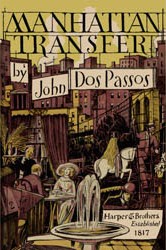.gif)
Manhattan Transfer (novel)
Encyclopedia

Novel
A novel is a book of long narrative in literary prose. The genre has historical roots both in the fields of the medieval and early modern romance and in the tradition of the novella. The latter supplied the present generic term in the late 18th century....
by John Dos Passos
John Dos Passos
John Roderigo Dos Passos was an American novelist and artist.-Early life:Born in Chicago, Illinois, Dos Passos was the illegitimate son of John Randolph Dos Passos , a distinguished lawyer of Madeiran Portuguese descent, and Lucy Addison Sprigg Madison of Petersburg, Virginia. The elder Dos Passos...
published in 1925. It focuses on the development of urban life in New York City
New York City
New York is the most populous city in the United States and the center of the New York Metropolitan Area, one of the most populous metropolitan areas in the world. New York exerts a significant impact upon global commerce, finance, media, art, fashion, research, technology, education, and...
from the Gilded Age
Gilded Age
In United States history, the Gilded Age refers to the era of rapid economic and population growth in the United States during the post–Civil War and post-Reconstruction eras of the late 19th century. The term "Gilded Age" was coined by Mark Twain and Charles Dudley Warner in their book The Gilded...
to the Jazz Age
Jazz Age
The Jazz Age was a movement that took place during the 1920s or the Roaring Twenties from which jazz music and dance emerged. The movement came about with the introduction of mainstream radio and the end of the war. This era ended in the 1930s with the beginning of The Great Depression but has...
as told through a series of overlapping individual stories.
It is considered to be one of Dos Passos' most important works. The book attacks the consumerism and social indifference of contemporary urban life, portraying a Manhattan
Manhattan
Manhattan is the oldest and the most densely populated of the five boroughs of New York City. Located primarily on the island of Manhattan at the mouth of the Hudson River, the boundaries of the borough are identical to those of New York County, an original county of the state of New York...
that is merciless yet teeming with energy and restlessness. The book shows some of Dos Passos' experimental writing techniques and narrative collage
Collage
A collage is a work of formal art, primarily in the visual arts, made from an assemblage of different forms, thus creating a new whole....
s that would become more pronounced in his U.S.A. trilogy
U.S.A. trilogy
The U.S.A. Trilogy is a major work of American writer John Dos Passos, comprising the novels The 42nd Parallel ; 1919, also known as Nineteen Nineteen ; and The Big Money . The three books were first published together in a single volume titled U.S.A by Harcourt Brace in January, 1938...
and other later works. The technique in Manhattan Transfer was inspired in part by James Joyce
James Joyce
James Augustine Aloysius Joyce was an Irish novelist and poet, considered to be one of the most influential writers in the modernist avant-garde of the early 20th century...
's Ulysses
Ulysses (novel)
Ulysses is a novel by the Irish author James Joyce. It was first serialised in parts in the American journal The Little Review from March 1918 to December 1920, and then published in its entirety by Sylvia Beach on 2 February 1922, in Paris. One of the most important works of Modernist literature,...
(1922), T. S. Eliot
T. S. Eliot
Thomas Stearns "T. S." Eliot OM was a playwright, literary critic, and arguably the most important English-language poet of the 20th century. Although he was born an American he moved to the United Kingdom in 1914 and was naturalised as a British subject in 1927 at age 39.The poem that made his...
's The Waste Land
The Waste Land
The Waste Land[A] is a 434-line[B] modernist poem by T. S. Eliot published in 1922. It has been called "one of the most important poems of the 20th century." Despite the poem's obscurity—its shifts between satire and prophecy, its abrupt and unannounced changes of speaker, location and time, its...
, and experiments with film collage by Soviet director Sergei Eisenstein
Sergei Eisenstein
Sergei Mikhailovich Eisenstein , né Eizenshtein, was a pioneering Soviet Russian film director and film theorist, often considered to be the "Father of Montage"...
.
Sinclair Lewis
Sinclair Lewis
Harry Sinclair Lewis was an American novelist, short-story writer, and playwright. In 1930, he became the first writer from the United States to be awarded the Nobel Prize in Literature, "for his vigorous and graphic art of description and his ability to create, with wit and humor, new types of...
described it as "a novel of the very first importance ... The dawn of a whole new school of writing." D.H. Lawrence called it "the best modern book about New York" he had ever read, describing it as "a very complete
film ... of the vast loose gang of strivers and winners and losers which seems to be the very pep of New York." In a blurb for a European edition, Ernest Hemingway
Ernest Hemingway
Ernest Miller Hemingway was an American author and journalist. His economic and understated style had a strong influence on 20th-century fiction, while his life of adventure and his public image influenced later generations. Hemingway produced most of his work between the mid-1920s and the...
wrote that, alone among American writers, Dos Passos has "been able to show to Europeans the America they really find when they come here."

